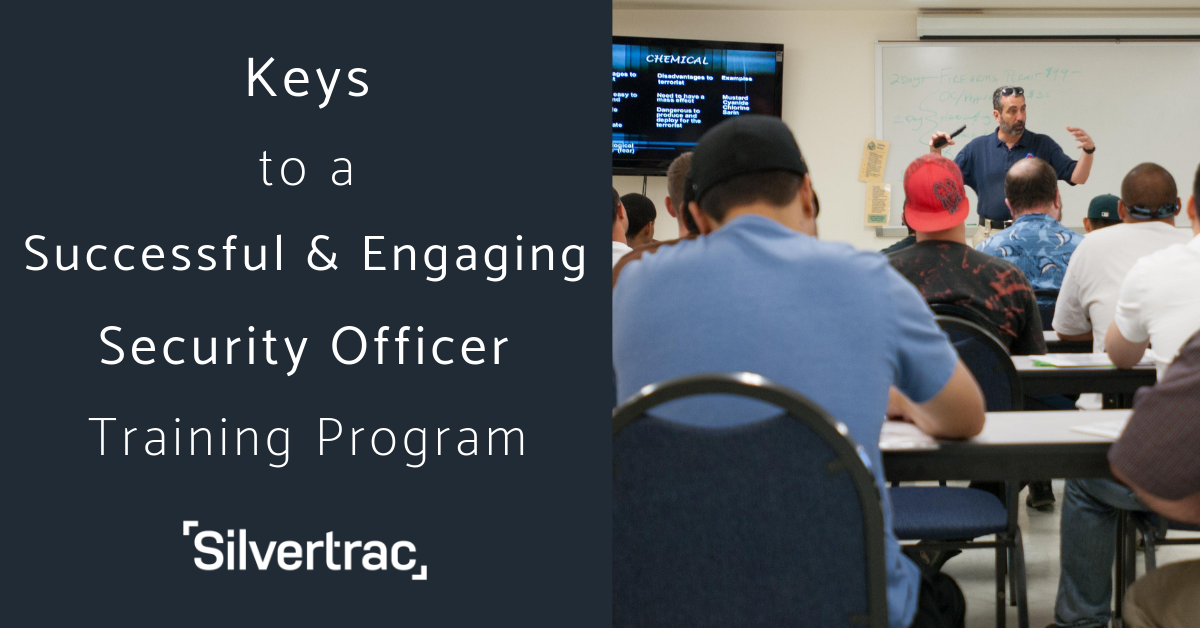The Silvertrac Extra
Keys to a Successful & Engaging Security Officer Training Program

How do you know if your employees are going to learn and, more importantly, retain what you teach them? It’s never an easy question to answer. I’ve done it for 32 years so I know first hand that it’s not easy. However, over the years I have learned a few things that help me keep security officers engaged during a live training session. Here are some tips that you can apply to your program that will help you achieve the same results.
Quality Instructors
Anyone can teach a security officer training class. I would say even a chimp can teach a class of employees something and possibly be more effective than some of the consultants/trainers I’ve listened to.
The first step to a creating the best security guard training program possible is finding a great instructor and materials list. Without those tools, you can’t successfully train anyone on anything.
It doesn’t matter if you utilize videos, books, manuals, handbooks, powerpoint presentations, or cartoon characters. If your instructor is as interesting as a cow patty it simply won’t work. But I have also seen people who could read the phone book and keep you interested like a Stephen King novel.
It’s about the instructor not necessarily the material. The best instructors will find ways to keep their audience involved in what is being taught.
Taking Action: Do your best to find a security training instructor that is personable, engaging, and excited about the class they’re teaching.
Effective Materials
Having your officers simply watch videos for 8 hours straight is boring and won’t end up producing the desired results. If the goal is to improve the level of service an officer can offer to your client in the field, sitting them in a room with a video and a handbook isn’t the most effective solution.
Now I’m not saying you have to exclude videos all together. But they should be used as a supplement to the instructor, not a replacement.
Videos, handbooks, posters, and the like can be very effective in training. The unfortunate part is that they are overused to such a degree that most officers don’t pay attention to them after the first few hours, whether they know the material or not. This can often lead to poorly trained officers, and poor retention of your contracts.
Taking Action: Use training materials like videos, handbooks, and powerpoints as a tool to complement the instructor’s efforts. Make sure that the tools you decide to use help you achieve the desired outcome. Don’t simply use video because everyone else is.
Security Officer Training Methods
The training method you utilize also has a great deal to do with how well it is received and retained by your officers. I use 3 different methods all melded together in my classes.
- The first method I use is an oldie but a goodie. KISS – Keep It Simple Stupid. This should be a commandment of everyone who trains people. Keep your training simple! It doesn’t matter if you’re training security officers, supervisors, or C-suite executives. Keep it simple.
The reasoning for this is just as simple. You are training your participants on something they may not know much about. Therefore you need to keep it at a basic level and build upon that as you go along. Even for C-suite MBA’s, you need to build on your subject and let them absorb what you’re teaching them - slowly. - The second method that I use is called "The Socratic Method". It is a simple yet very effective way of teaching people. In essence they train themselves. Instead of giving them the answers I ask them open-ended questions and have them tell me the answers.
If they don’t know the answers they sit and stew for a few seconds. But in the process, they are throwing out answers that are both right and wrong. I tell them if they are on the right track or not. This allows the students to engage in the learning process and participate in the discovery of new material.
Again, it’s a matter of dragging the correct answer out of them and making them think it through. Depending on who you’re training, they can over think the answer and never get on the right track or just be as basic as possible and get it on the first try. And it also encourages them to build on each other’s answers to find the right one. - Lastly, I employ a shock method of training. I usually start my classes off with a hook that can’t be ignored. They need to understand why they are in the course and what’s in it for them.
Start with a story or example that gets everyone’s attention. It makes them sit up, take notice, and wonder what’s going to happen next. And while it may be a bit theatrical and dramatic it is effective.
Summarizing the Main Points
- The instructor is a critical part of the process. Without a good instructor you’re fighting an uphill battle.
- Chose your training material carefully. Get rid of the extra and focus on what’s necessary to deliver the desired result.
- Keep it simple.
- Engage your students in an interactive learning environment.





